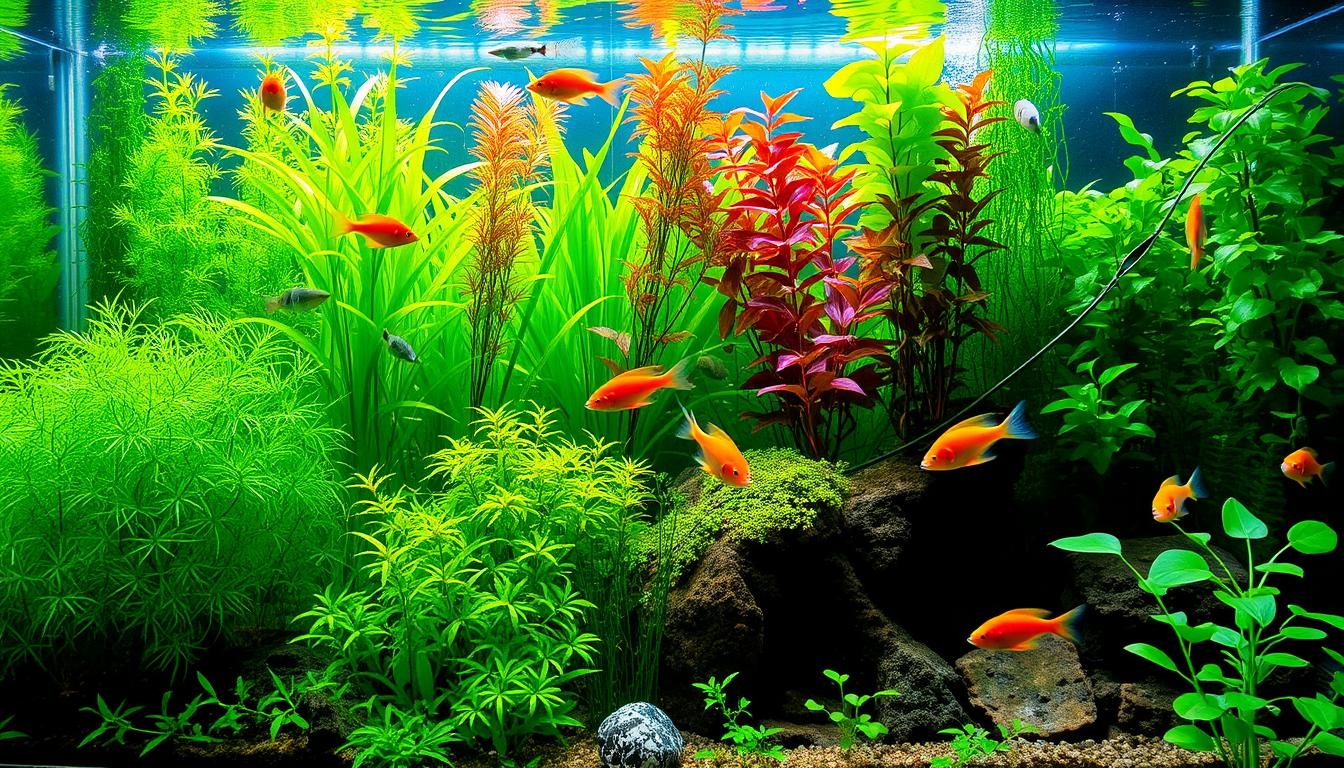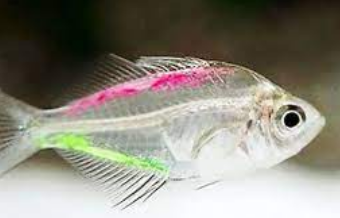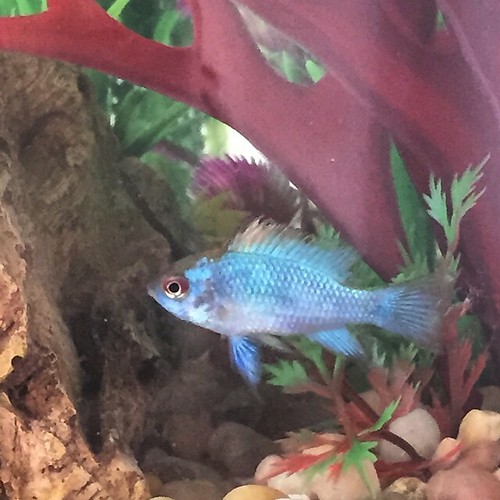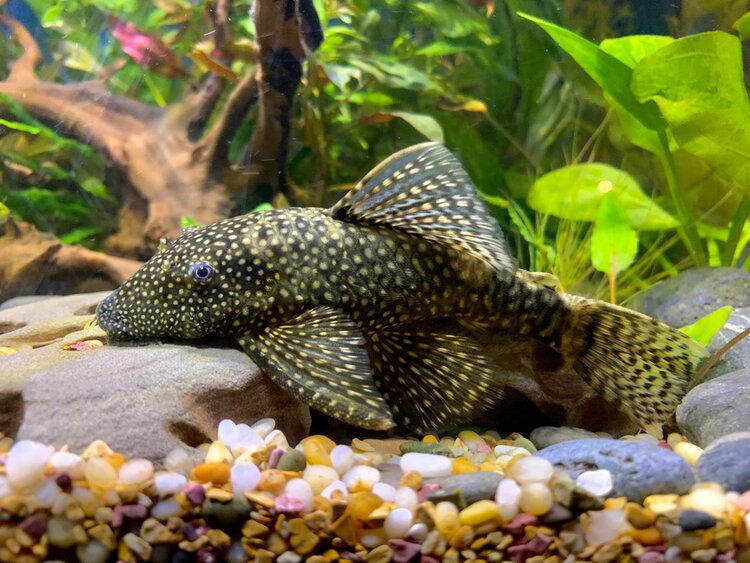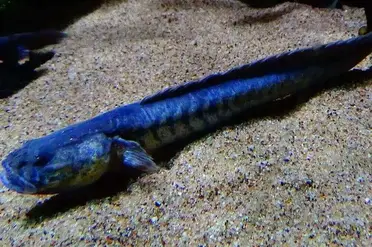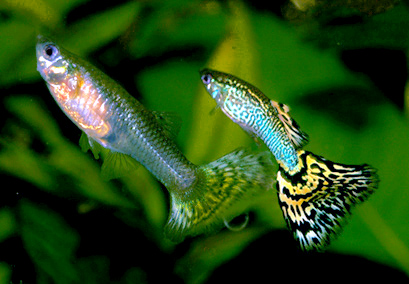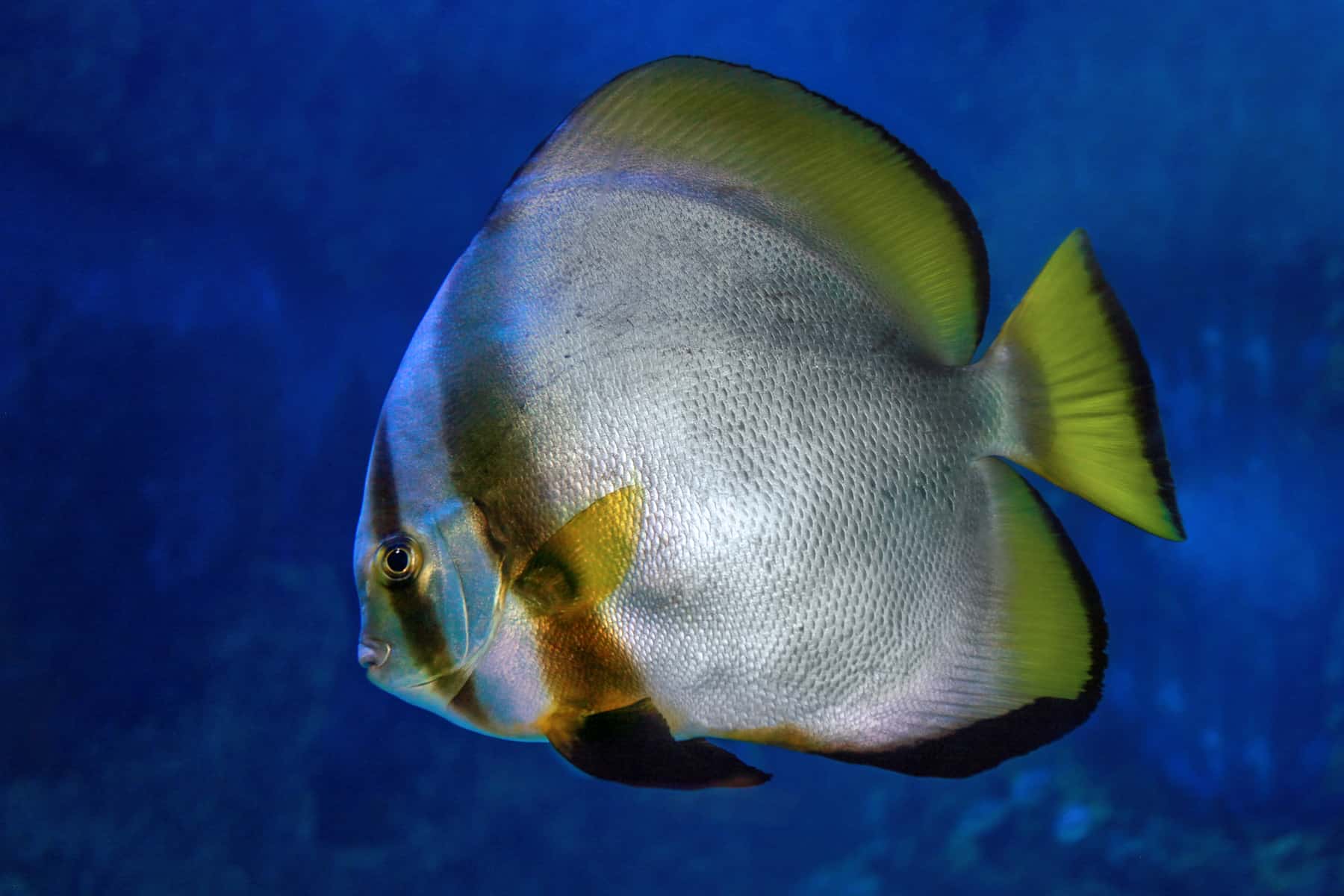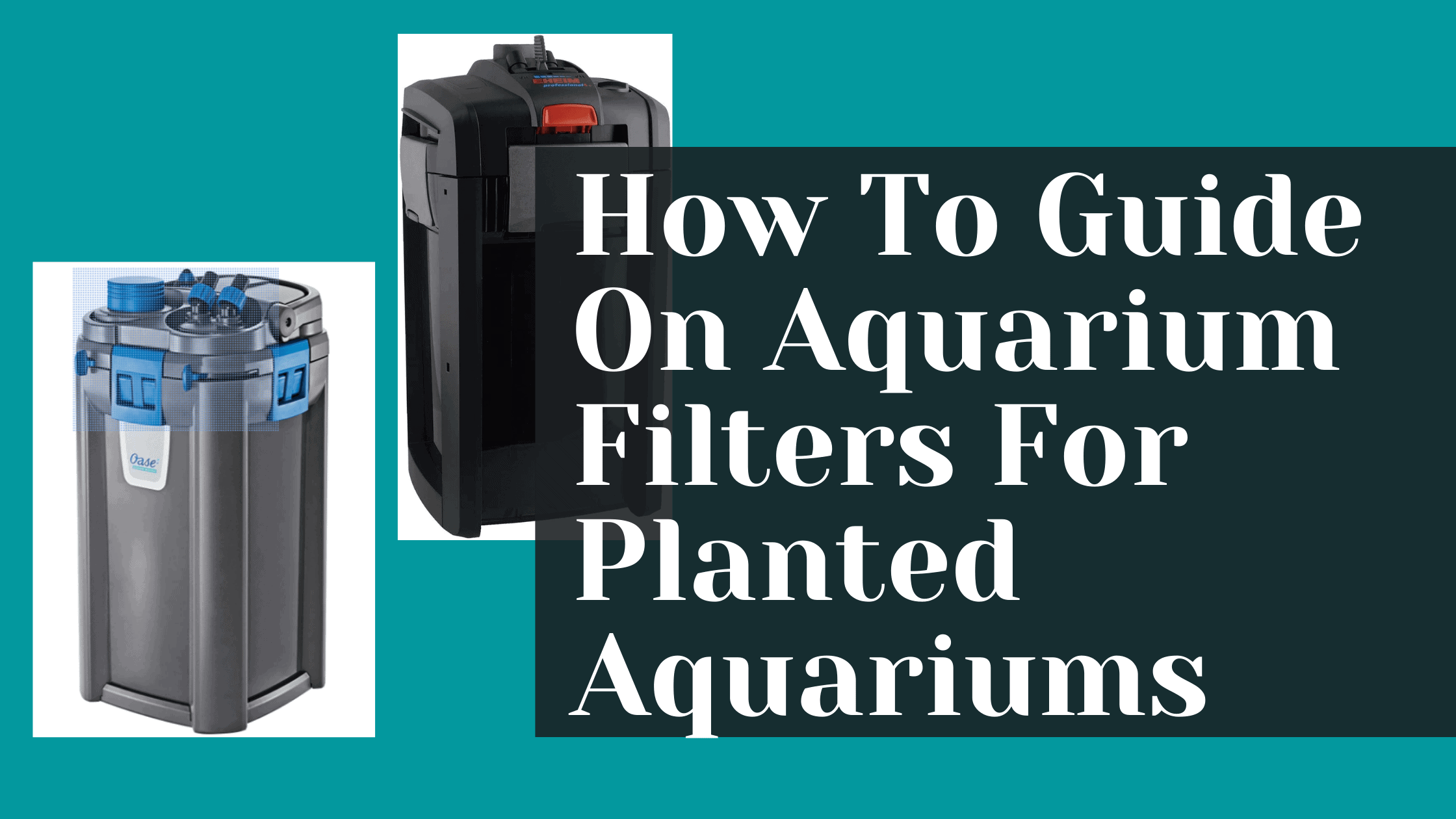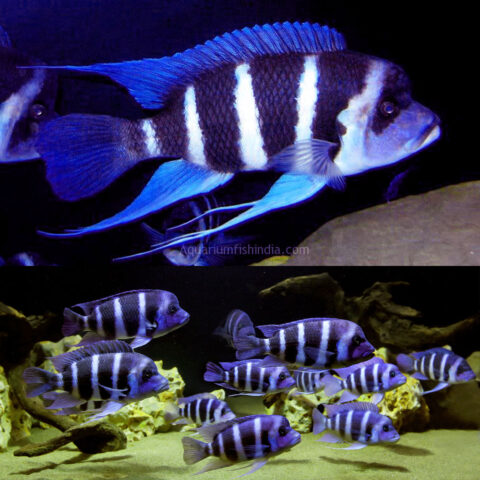Did you know some aquarium plants can grow up to 2 inches per day? These fast-growing plants are not just pretty. They also help your tank’s ecosystem by fighting algae and providing homes for fish. The fastest growing aquarium plants are key for any aquarist wanting a thriving underwater world.
This guide will show you the top 10 fastest growing aquarium plants. You’ll learn how easy plants like Duckweed, Anacharis, and Hornwort can quickly eat up excess nutrients and oxygenate the water. They also give your fish places to hide. These plants are great for both beginners and experts, making your aquarium look stunning with little work.
Table of Contents
Key Takeaways
- Fast-growing aquarium plants can grow up to 2 inches per day, quickly filling your tank with lush greenery.
- These plants help combat algae growth by competing for light and nutrients, leading to a cleaner and healthier aquarium.
- Many fast-growing aquarium plants are easy to maintain and suitable for beginners, making them an excellent choice for new aquarists.
- Oxygenating aquarium plants like Anacharis and Hornwort improve water quality and provide a natural habitat for your fish.
- Regular pruning is essential to control the growth of these plants and maintain a visually appealing aquascape.
The Benefits of Fast-Growing Aquarium Plants
Exploring aquatic plant care and planted aquariums shows the value of fast-growing live aquarium plants. These plants make our tanks look better and help our aquatic friends stay healthy.
Combating Algae Growth
Fast-growing plants are great at stopping algae from taking over. Plants like Salvinia Natans and Red Root Floaters spread quickly and shade the tank, stopping algae from growing. They also take nutrients that algae need, which helps keep algae away.
Egeria Densa is known for taking in excess nutrients, which stops algae from growing back.
Improving Water Quality
Fast-growing plants also keep the water clean by taking in harmful substances like ammonia and nitrite. They help balance the water chemistry and keep it safe for fish. Plus, they clean the water by removing waste, making it better for fish and plants alike.
| Plant Species | Growth Rate | Water Quality Benefits |
|---|---|---|
| Rotala species | 1-2 inches per week | Absorbs excess nutrients |
| Water Wisteria | Rapid growth, easily propagated | Filters out waste products |
| Pearl Weed | Quickly covers substrate | Absorbs ammonia and nitrate |
Creating a Natural Environment for Fish
Fast-growing plants make a tank feel more natural for fish. They give fish safe places to lay eggs and hide. This makes fish feel secure and happy. Plus, these plants help feed baby fish, helping them grow strong.
- Fast-growing plants provide additional oxygen to the aquarium, promoting fish health
- They create a natural environment for breeding fish, offering safe areas for adults to lay eggs and for fry to hide
- The dense growth fosters the development of microorganisms that serve as crucial food sources for newly hatched fry
As I learn more about planted aquariums and aquatic plant care, I see how important fast-growing live aquarium plants are. They fight algae, improve water quality, and make a natural home for fish. These plants are key to my aquarium success.
Salvinia Natans (Floating Fern)
Salvinia Natans is also known as the Floating Fern, Water Butterfly Wing, or Floating Watermoss. It’s a fast-growing plant that makes any freshwater tank look unique. It floats on the water’s surface, adding beauty and helping the ecosystem.
Unique Appearance and Growth Habits
Salvinia Natans stands out with its special look. Its leaves are shaped like butterfly wings and have fine hairs. This gives them a fuzzy feel and a shiny green look from above.
This plant grows outward, not upward. With the right care, it spreads out, covering the water. This not only looks beautiful but also helps the tank in many ways.
| Characteristic | Description |
|---|---|
| Scientific Name | Salvinia natans |
| Family Name | Salviniaceae |
| Habitat | Freshwater |
| Temperature | 60°F to 70°F |
| Height | 2 to 3 inches |
| pH | 6.5 to 7.5 |
| Lighting | Bright |
Effective Light Blocker and Algae Competitor
Salvinia Natans is great for aquariums because it blocks too much light. It creates a shade on the water’s surface. This stops algae from growing, as they need lots of light.
Salvinia Natans is an excellent addition to aquariums, providing shade, oxygen, and aiding in water clarity.
This plant also fights algae by taking up nutrients in the water. Being fast-growing, it grabs nitrates and phosphates before algae can. This keeps the tank balanced and healthy.
Red Root Floaters
Red Root Floaters add a pop of color to any aquarium. They are easy to care for and boost your tank’s health. As they grow, they form a dense mat on the water’s surface. This mat shades the aquarium and controls algae growth.
Striking Red Coloration
Red Root Floaters stand out with their vibrant red color. Under bright lights, their leaves turn a deep red, making your tank look stunning. In dimmer light, they keep a bright green color with red edges. This flexibility lets them fit into many aquarium setups.
| Light Conditions | Leaf Color |
|---|---|
| High light (436 umols of PAR) | Greenish leaves |
| Low light (189 umols of PAR) | Reddish leaves |
The color of Red Root Floaters also changes with the water’s nitrogen levels. Redder leaves mean low nitrate levels, while greener leaves suggest higher nitrogen. This makes them a great way to check your tank’s nutrient balance.
Dense Surface Coverage and Nutrient Absorption
Red Root Floaters grow fast and cover your aquarium’s surface quickly. This coverage brings many benefits, including:
- Shading the aquarium to control algae growth by reducing light
- Absorbing excess nutrients and toxins, which stops algae from growing
- Creating a peaceful look that mimics a still pond or lake
As they grow, Red Root Floaters develop long, delicate roots. These roots help oxygenate and clean the water, especially in tanks with weak flow or filters.
Red Root Floaters are not just pretty; they also help keep your aquarium healthy and balanced.
Take care of Red Root Floaters by keeping the current gentle and avoiding rough water. With the right lighting, nutrients, and water conditions, these plants will flourish and beautify your tank.
Java Moss
Java Moss is a top pick for easy aquarium plants for beginners, doing well in low to moderate light. It’s great for new aquarium owners because it’s easy to care for and fits many tank settings. Being a low-light aquarium plant, it grows well without needing CO2 or strong lights, making it ideal for beginner aquarium plants.
Java Moss is incredibly adaptable. It can handle temperatures from 59°F to 86°F (15°C to 30°C), but it prefers cooler temperatures. This flexibility lets it grow indoors or outdoors, depending on your area. It even does well in tanks with little light, tap water, and minimal food, showing its toughness as a low-light aquarium plant.
I’ve had great success with Java Moss in my low-tech tank. It grows slower than in high-tech setups, but it covers a lot of the tank over time. I love how it looks natural and provides hiding spots for my fish and shrimp.
Here are some tips for the best growth:
- Provide good lighting, macro, and micro nutrients
- Use CO2 injection for faster, fuller growth
- Keep the water temperature steady between 70-75°F (21-24°C)
- Separate Java Moss into narrow strips to help it spread
Java Moss grows about 1mm per week or 1.5 inches per month on average. It grows faster than mosses like Flame Moss and Christmas Moss. With the right care, it can quickly cover a lot of your tank. A fellow aquarist reported Java Moss covering 40% of their 150-gallon tank in 6 months.
| Tank Size | Lighting Setup | Growth Rate |
|---|---|---|
| 10 gallons | 23 watts | 1mm per week |
| 24 gallons | 48 watts | 1.5 inches per month |
| 150 gallons | Traditional T8 15W bulb | 40% coverage in 6 months |
In conclusion, Java Moss is a great choice for beginner aquarium plants. It’s easy to care for and can grow in many conditions. It also provides a natural look and shelter for fish and shrimp, making it a top pick for low-light aquarium plant lovers.
Rotala Narrow Leaf Sp. Red
Rotala Narrow Leaf Sp. Red is a standout among fast-growing aquarium plants. It brings a vibrant splash of color to any tank. Its vibrant red foliage and narrow leaves make it a striking addition to your aquatic landscape.
Vibrant Red Foliage
Rotala Narrow Leaf Sp. Red is known for its intense red color. It thrives under strong lighting (150-200 umols of PAR) and low nitrate levels (5ppm or below). This plant develops a deep, rich red hue that catches the eye.
Rotala ‘blood red SG version’ is a stunning variant. It requires less nitrate limitation to achieve its deep red colors. However, it is not as widely available in the aquarium trade.
Fast Growth and Propagation
This plant grows rapidly, especially with ample light and nutrients. In a high-light, nutrient-rich environment, it can grow 1-2 inches per week. It quickly fills out your aquascape.
To keep the plant looking its best, regular trimming is needed. Propagation is easy with this species:
- Simply snip the stem at your desired length
- Remove the lower leaves from the cut portion
- Replant the stem into the substrate
With consistent pruning and replanting, you can create a lush, vibrant bush. This will be the focal point of your aquarium.
| Rotala Species | Difficulty Level | Light Requirements | CO2 Requirements |
|---|---|---|---|
| Rotala rotundifolia | Easy | Moderate to High | Beneficial but not essential |
| Rotala macrandra | Intermediate | High | Essential for optimal growth |
| Rotala wallichii | Intermediate | High | Essential for optimal growth |
| Rotala ‘Vietnam’ | Intermediate | High | Essential for optimal growth |
Egeria Densa (Anacharis or Elodea)
Egeria Densa, also known as Anacharis or Elodea, is a great choice for aquarists. It has vibrant green leaves that add a lush look to any tank. This plant grows well in many lighting conditions, from low to high light.
Nutrient Absorption and Algae Control
Anacharis is great at absorbing nutrients from the water. It stops algae from growing by taking up excess nutrients. This keeps the water clean and prevents algae outbreaks.
Anacharis is a true workhorse when it comes to keeping my aquarium clean and clear. Its ability to absorb nutrients and control algae growth has made my life as an aquarist so much easier!
Dense Growth and Shelter for Tank Inhabitants
Anacharis grows quickly and needs regular pruning. But its dense growth is good for tank creatures. It provides shade and shelter for fish and shrimp.
It also helps by increasing oxygen in the water. This makes the tank a healthy place for all living things.
| Characteristic | Description |
|---|---|
| Height | Up to 3 feet in nature, 6-8 inches in stores |
| Temperature | 72-78 °F (22-25 °C) |
| pH | 6.0-8.0 |
| Water Hardness | 2-20 dGH |
| Lighting | Medium to high, LED lights recommended |
| Substrate | Gravel (if rooted) |
| Fertilization | Substrates with high organic content, weekly CO2 and substrate fertilizer |
Egeria Densa (Anacharis or Elodea) is a versatile and fast-growing aquarium plant. It helps control algae, improves water quality, and gives shelter to tank creatures. It’s a must-have for any thriving aquarium.
Hygrophila Difformis (Water Wisteria)
As a beginner in aquariums, I’ve learned that Hygrophila Difformis, or Water Wisteria, is great for new aquarists. It grows fast and fits many tank conditions. This makes it perfect for those starting out.
Water Wisteria can grow up to 20 inches tall and 10 inches wide. It’s a beautiful plant for large tanks. But, in smaller tanks, trimming it keeps it neat and fits well in different designs.
This plant grows fast, up to 0.5-3 inches a day. It adds beauty to the tank and fights algae by taking up nutrients and light. It’s great for beginners because it fills out the tank quickly, making it look natural and full of life.
Water Wisteria’s fast growth rate allows for easy propagation through stem cutting and replanting, which increases its appeal to aquarists looking to increase their tank’s plant volume and density quickly.
Water Wisteria is easy to care for. It can handle a lot of different temperatures, pH levels, and light conditions. It grows best with medium to high light but can do well with less light too. This makes it flexible for many tank setups.
| Characteristic | Value |
|---|---|
| Maximum Height | 20 inches (51 cm) |
| Maximum Width | 10 inches (25 cm) |
| Growth Rate | 0.5-3 inches (1-8 cm) per day |
| Ideal Temperature Range | 75°F to 82°F (24°C to 28°C) |
| Preferred pH Range | 6.5 to 7.5 |
| Lighting Requirement | Medium to High |
In summary, Hygrophila Difformis (Water Wisteria) is perfect for beginners. It’s fast-growing, easy to care for, and can quickly make tanks look lush and green. Its adaptability and easy propagation make it a top choice for creating a beautiful home for fish.
Bacopa Caroliniana
Bacopa Caroliniana is a fast-growing plant from the southeastern United States. It’s loved for its green leaves and ability to fit in many tank settings. It can grow up to 60 cm tall, making it perfect for the background or midground in aquariums.
Thick Green Leaves and Upright Growth
Bacopa Caroliniana stands out with its thick, green leaves that grow upright. This plant makes the aquarium look lush and natural. The leaves are usually green but can turn reddish when given enough iron and nutrients.
Adaptability to Various Tank Conditions
This plant can live in many tank conditions. It handles pH levels from 6.0 to 8.0 and water hardness from 2 to 15 GH. The best water temperature for it is between 68 and 82 degrees Fahrenheit.
It needs at least 0.5 watts per liter of light to grow well. High light is best for it. While it grows without extra help, CO2 and nutrients make it grow faster and healthier.
| Characteristic | Description |
|---|---|
| Height | Up to 60 cm |
| Lighting | At least 0.5 watts per liter; high light recommended |
| pH Range | 6.0 – 8.0 |
| Water Hardness | 2 – 15 GH |
| Temperature Range | 68 – 82°F (20 – 28°C) |
| Propagation | Stem cuttings (3 – 6 inches) |
Propagating Bacopa Caroliniana is easy. Just take stem cuttings of 3 to 6 inches and plant them in the substrate. Cutting lateral shoots and replanting them makes the plant fuller and bushier.
Bacopa Caroliniana is a low-maintenance, fast-growing aquarium plant that is suitable for both beginners and experienced aquarists alike.
This plant is great for those wanting a natural look in their tanks. Its adaptability, lush foliage, and easy propagation make it a top choice.
Hydrocotyle Leucocephala (Brazilian Pennywort)
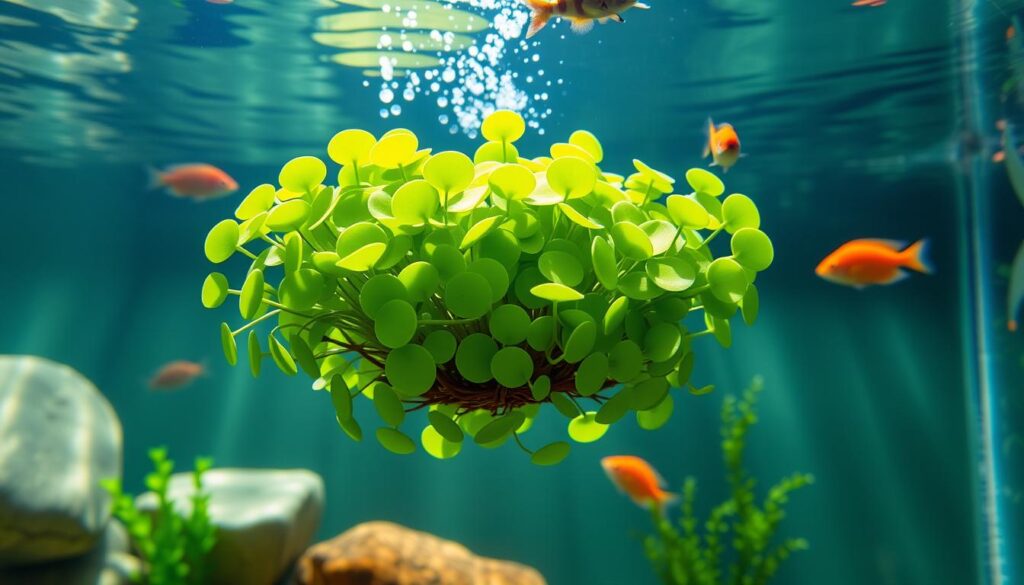
Hydrocotyle leucocephala, also known as Brazilian Pennywort, is a popular choice for aquariums. It’s known for its fast-growing nature and unique clover-like leaves. This plant is great for both beginners and experts because it’s easy to care for and grows quickly.
Brazilian Pennywort is great at stopping algae from growing. It takes nutrients from the water, which helps keep algae away. But, it grows fast, so you’ll need to trim it regularly to keep it from taking over the tank.
This plant can live in many water conditions, making it versatile for different tank setups. It does well in the following water conditions:
| Parameter | Range |
|---|---|
| pH | 6.0 – 7.8 |
| Temperature | 68°F – 82°F (20°C – 28°C) |
To keep Brazilian Pennywort looking lush, give it medium to high light and CO2. Use a nutrient-rich substrate to help it grow and stay colorful. Trimming new growth will help it spread out and create a full carpet in your tank.
Brazilian Pennywort is easy to reproduce. Just cut a few inches off a stem with leaves or even a single healthy leaf with stem attached.
You can find Brazilian Pennywort in different forms like fresh-cut, bunched, or potted plants. When buying, check the shipping policies and live arrival guarantees for the best experience with this carpeting aquarium plant.
Vallisneria Gigantea Rubra
Vallisneria Gigantea Rubra is a great choice for fast-growing aquarium plants. It adds a unique touch to your tank with its long, flowing leaves in a reddish color. This makes it a standout in any aquascape.
Distinctive Reddish Hue
Vallisneria Gigantea Rubra is known for its unique color. The leaves can turn reddish, from a light to a deep red, based on your tank’s lighting and nutrients. This color adds warmth and vibrancy to your aquarium, making it look stunning.
The reddish hues of Vallisneria Gigantea Rubra can vary from subtle to more pronounced, depending on the lighting and nutrient conditions in the tank.
To get the plant’s leaves to turn reddish, you need medium to high lighting and nutrient-rich soil. It prefers a pH of 6.5 to 8.0 and a temperature of 72°F to 82°F (22°C to 28°C).
Rapid Background Growth and Algae Competition
Vallisneria Gigantea Rubra grows fast, making it perfect for creating a lush background in your tank. It can grow several feet tall, depending on your aquarium’s size.
| Characteristic | Description |
|---|---|
| Growth Rate | Fast |
| Typical Height | Several feet, depending on tank size |
| Placement | Background (typically), midground (larger tanks) |
| Propagation Method | Runners (horizontal stems that grow new plants at intervals) |
This plant is also great at fighting algae. It needs a lot of nutrients, which helps it beat algae for resources in your tank. This keeps your tank balanced and free from algae.
As it grows, Vallisneria Gigantea Rubra creates a dense canopy that shades and shelters your fish. You might need to trim it to keep it from taking over. But it grows back fast, so trimming won’t be a big deal.
- Vallisneria Gigantea Rubra is a fast-growing aquarium plant with a distinctive reddish hue
- It can reach impressive heights, making it an ideal background plant
- The plant’s rapid growth and high nutrient demand help to outcompete algae
- Regular trimming may be necessary to control its growth in the aquarium
Pearl Weed (Hemianthus Micranthemoides)
I highly recommend Pearl Weed (Hemianthus Micranthemoides) for a lush look in your tank. It’s a fast-growing plant from the United States, thriving in Florida’s small wet pools and stagnant waters. It forms dense mats of small shoots.
Dense Carpeting Growth
Pearl Weed is a low-growing stem plant that spreads quickly. It’s perfect for carpeting your aquarium’s foreground, midground, or background. With its fast growth, your tank will look lush in no time. But, you’ll need to trim it regularly to keep it looking good and prevent overcrowding.
With enough light, CO2, and nutrients, Pearl Weed grows sideways. It covers large areas of the substrate quickly, making your aquascape look stunning.
Effective Nutrient Absorption and Algae Prevention
Fast-growing plants like Pearl Weed absorb excess nutrients from the water. This helps keep the water clean and prevents algae outbreaks. Algae can be a big problem for aquarium owners.
To help Pearl Weed grow well, feed it liquid fertilizers like Tropica Premium or Specialised Nutrition. These fertilizers give it the nutrients it needs for healthy growth and bright colors.
| Characteristic | Details |
|---|---|
| Light Intensity | Approx. 0.5 watts per liter or more |
| Water Temperature | 20-28°C (68-82°F) |
| pH Range | 5.5-7.5 |
| Lighting Requirements | Medium to high |
| Placement in Aquarium | Foreground to background |
| Growth Rate | Fast |
Pearl Weed is great for creating a stunning, carpeted look in your tank. It also helps keep your aquarium healthy. With proper care and the right conditions, you can enjoy this fast-growing plant in your aquarium.
Fastest Growing Aquarium Plants: A Comprehensive List
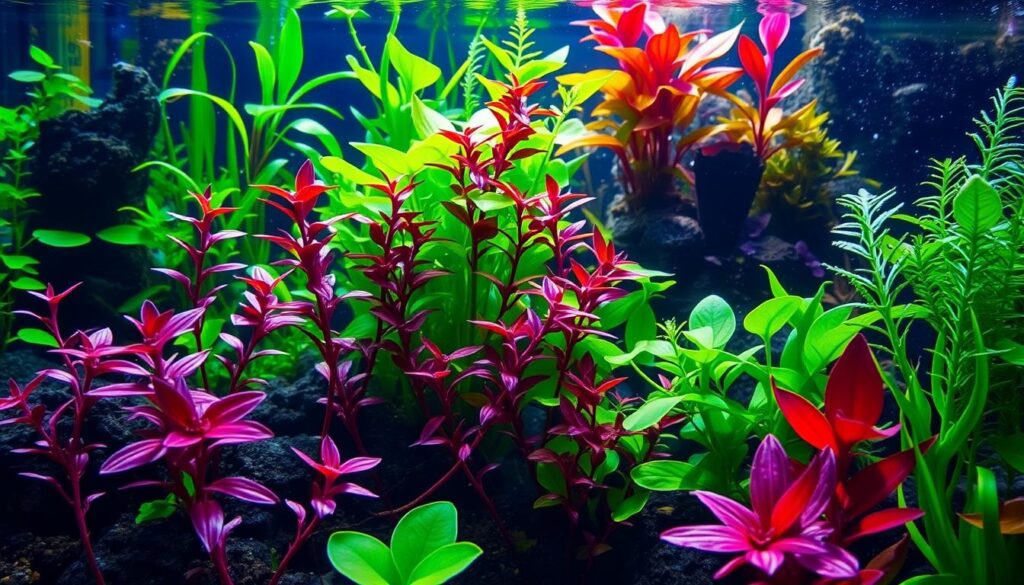
Adding fast-growing aquatic plants to your aquarium is key for a thriving ecosystem. These plants are easy to care for and make your tank look great. They also help keep the water clean and provide a home for fish and other creatures. Here are some of the best fast-growing plants for your aquarium.
Duckweed
Duckweed grows super fast, doubling in size in just days. It floats on the water’s surface, creating a lush cover. But, it can spread quickly, so you’ll need to trim it often.
Hygrophila Species
Hygrophila plants grow quickly and fit well in many tank setups. You can easily spread them by cutting stems. They also clean the water by taking in extra nutrients.
Hornwort
Hornwort is loved for its fast growth and flexibility. You can let it float or tie it down. Its thick leaves offer great hiding spots for fish and help keep the water oxygenated.
Rotala Rotundifolia
Rotala Rotundifolia is a beautiful plant with pink and red colors. It grows fast, filling your tank with vibrant colors. It also recovers quickly after trimming, making it easy to care for.
Shinnersia Rivularis (Mexican Oak Leaf)
Shinnersia Rivularis looks like an oak leaf and grows super fast. Its unique leaves add texture to your tank. But, it grows quickly, so you’ll need to prune it often to keep it balanced.
| Plant Name | Growth Rate | Propagation Method |
|---|---|---|
| Duckweed | Doubles population in days | Floating reproduction |
| Hygrophila Species | Fast | Stem cuttings |
| Hornwort | Rapid | Floating or anchored |
| Rotala Rotundifolia | Fast | Stem cuttings |
| Shinnersia Rivularis | Very fast | Stem cuttings |
When adding these plants to your tank, think about how fast they grow and how often you’ll need to trim them. Regular care keeps your plants healthy and your tank balanced. These plants are great for both new and experienced aquarium owners who want a beautiful underwater garden.
Conclusion
Adding the fastest growing aquarium plants to your tank changes the game for aquarists. These plants make your tank look better and help your fish stay healthy. They fight algae, improve water quality, and create a natural home for your fish.
This guide has shown you some top live aquarium plants for all aquarists. Salvinia Natans looks like a floating fern and keeps the water cool. Red Root Floaters bring color and help with nutrient absorption. Java Moss is easy to care for and makes your tank look lush.
Rotala Narrow Leaf Sp. Red grows fast and has bright red leaves. Egeria Densa is great at taking in nutrients and gives fish a place to hide. Hygrophila Difformis is a beautiful plant for the center of your tank.
Bacopa Caroliniana has thick green leaves and fits well in any tank. Hydrocotyle Leucocephala is perfect for beginners. Vallisneria Gigantea Rubra grows fast and has a unique red color. Pearl Weed forms a dense carpet that stops algae from growing.
With so many fast-growing aquarium plants to pick from, you can make a beautiful and healthy aquarium. Your tank will be the talk of the town among aquarists.
FAQ
What are the benefits of adding fast-growing aquarium plants to my tank?
How do fast-growing plants help prevent algae growth in aquariums?
Are fast-growing aquarium plants easy to care for?
Can fast-growing plants help oxygenate my aquarium water?
Which fast-growing plants are best for low-light aquariums?
How often should I trim fast-growing aquarium plants?
Can I propagate fast-growing aquarium plants easily?
I am a passionate aquarist with over 30 years of hands-on experience in fishkeeping. My journey began at a young age, collecting fish from the wild and learning through experimentation. Specializing in tropical fish, I bring a deep understanding of the hobby to FishKeepingMadeSimple. The site provides honest, detailed reviews of essential products and accessories to help fellow enthusiasts create the best environments for their fish.

